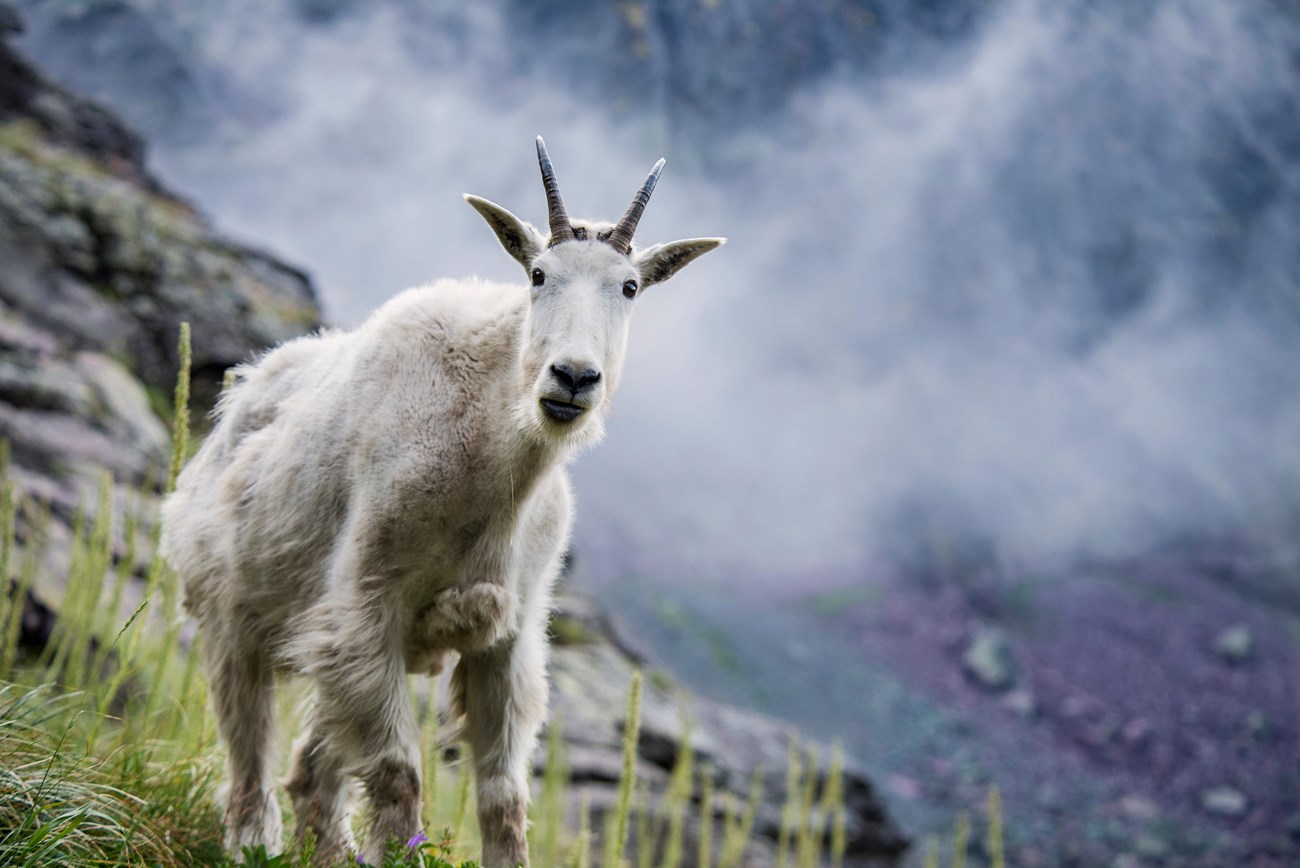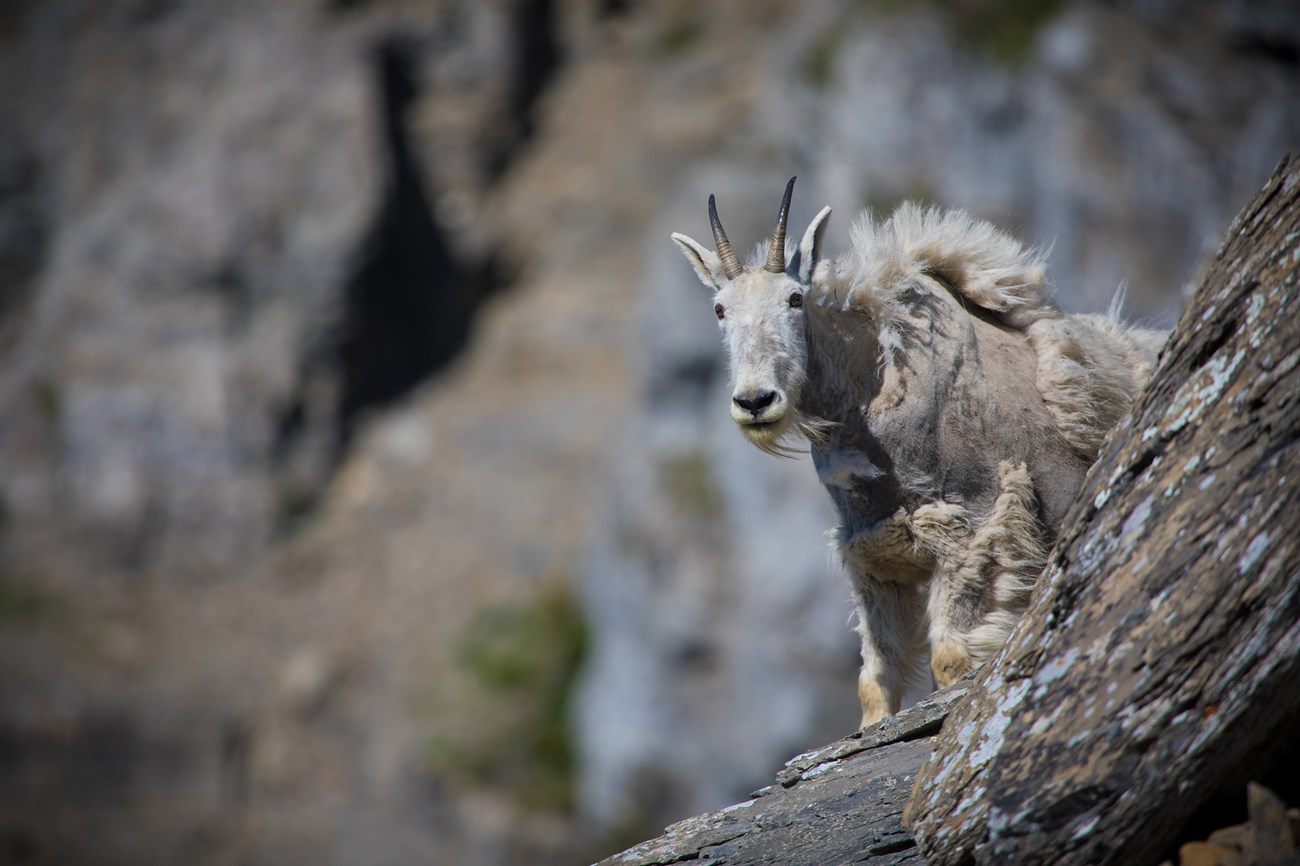Last updated: November 20, 2024
Article
A New Mechanism for Monitoring Mountain Goats

Citizen scientists in Glacier assist with documenting a wide variety of taxa from pikas to migratory raptors, moths, and aquatic invertebrates. In 2008, the program launched its High Country Citizen Science Mountain Goat and Bighorn Sheep Monitoring project. This project provides biologists and resource managers with population and distribution information necessary to track status and trends of these iconic mountain ungulates and assist with management within the park.

Glacier National Park hosts the largest native population of mountain goats in the lower 48 states. Emblematic and easily detectable, mountain goats are a great species to raise awareness for conservation and population management. As high elevation habitat specialists, they are excellent indicators of alpine ecosystem health. This makes them an important species to monitor as the environments within the park are changing due to climate warming, increasing wildfire frequency and severity, loss of snowpack and changes in spring precipitation. Mountain goats also share habitat with bighorn sheep, enabling us to monitor both simultaneously and track changes in distribution and overlap between these two species. Additionally, as tourism to Glacier continues to increase, human-wildlife interactions follow suit, and many, once-isolated “goat haunts” are frequented by the public. Previous research in Glacier has documented that increased habituation of goats has impacted their behaviors and the types of habitats they use.
The primary project objective is to track population trends and provide baseline population and distribution estimates for goats. This project has engaged the public in continuous and consistent data collection since 2008 and has succeeded in achieving survey coverage at each of the 37 monitoring sites at least 3 times each season (average of 5 surveys per site). With over 15 years of data, the team has a huge pool of data to draw from to inform management decisions.

When the program started in 2005, paper data sheets were the norm. As word spread for the High Country project, participation grew, fulfilling more research needs for the managers at Glacier National Park. However, the program quickly hit the edge of capacity to keep up with the time demands of paper data entry while maintaining a high standard of data quality. In 2019, the team implemented mobile data collection using ArcGIS Survey123. The tool’s success and capacity was mind-blowing, and Survey123 was quickly adopted as a critical tool for data collection, quality control and management. Survey123 is an indispensable tool for directing volunteers in data collection by allowing the embedding of instructions, photo tutorials, survey location geopoints and other teach-as-you-go features into the surveys. It also refines the options that volunteers can select in each data field, bringing uniformity to the data collection amongst a pool of volunteers with highly diverse skillsets and backgrounds.
This Glacier Mountain Goat Survey123 form is designed to collect a multitude of data starting with information about the study site, conditions for the day, and specific location. They all self-sum to allow biologists easier data management and enable efficient in-field data review. Many of the fields are coded to be conditional so the viewer’s screen is not clogged with excess fields they cannot fill out. For example, if the observers don’t see goats at all, the drop down with the detailed questions about sightings and self-summing count fields do not appear. This allows observers to focus time and attention on watching wildlife and terrain instead of getting distracted by screen clutter.

Arguably, the more interesting portion of the survey forms are the interactive maps embedded within the form. These maps provide surveyors with each observation point and associated quadrants, aerial imagery, and topographic lines to orient the surveyor to the site and document the locations of goats and sheep using geopoints. The interactiveness allows the surveyor to explore the topography of the area around them for further information. By embedding feature layers within Survey123, the forms are fully independent, so only one program is needed to complete the observation. At the end of the survey, there is an opportunity to document any additional animal sightings, allowing the collection of more valuable data. This data is used to inform other biologists of relevant information throughout the park. The team also requests that observers upload pictures alongside the survey so that biologists can quality check observations after submission, allowing confirmation that each photo of goats and sheep submitted is correctly identified and classified. In this way, the survey efforts produce a high volume of repeatable high-quality data.
The data submitted was reviewed weekly and marked by using hidden fields in ArcGis Online to indicate whether data has been Quality Assurance/Quality Controlled. Any data that needed to be reviewed with volunteers or treated specially during analysis was flagged. After collection and quality control, the survey populates a Web Map that updates survey sites to indicate whether or not they have been visited recently by turning the points red or green. This makes it far more efficient for citizen scientists to independently figure out where to visit next and allows the team to view the progress of survey efforts for the season.
With an incredible diveristy of species and landscapes to protect in Glacier National Park, information is vital. The leap forward in capacity and data quality that the team has achieved by using Survey123 is invaluable to further the goal of the citizen science program. Having a larger capacity ensures that biologists are provided with the whole picture of what is happening in the landscape, helping to better inform management decisions to ensure the future of Glacier’s natural ecology. This is especially important with mountain goats and bighorn sheep as their range within the park is wide and their activity is varied. Armed with Survey123, ecological knowledge, and a love for the natural world, Citizen Scientists are helping to protect their beloved park, one survey at a time.

